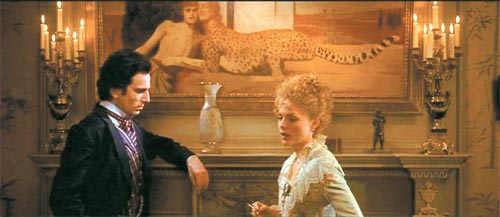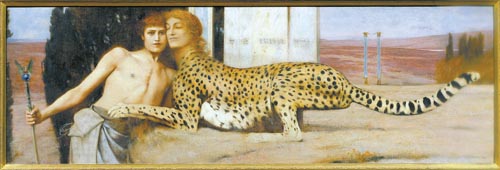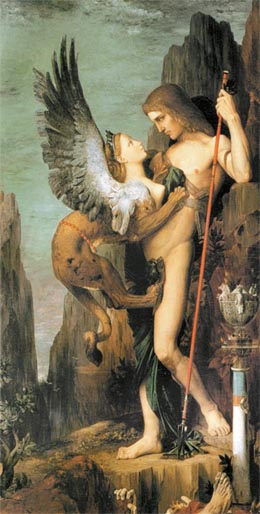Symbols of power in the age of innocence

A scene from “The Age of Innocence” (1993)
Ellen was living in Europe following her marriage to a Polish count, but has left her abusive husband and returned to America. When she arrives, she receives a cold reception from the conservative social circle to which she belongs. Yet she still plans to go ahead with her plans to divorce her husband, an act that was essentially forbidden at the time. Ellen’s family is strongly opposed to the plan, believing it would bring them disgrace, and asks Newland to dissuade her from the divorce. He agrees, but comes to feel a fascination and sympathy for Ellen as he watches her fight the constraints of society by herself.
This is the plot of the 1993 film “The Age of Innocence,” based on the Pulitzer Prize-winning novel by Edith Wharton of the same title. When Martin Scorsese said he would direct the movie, many were surprised, because the director was known for his tough movies about the back streets and underworld of the New York he once knew, and not for elegant period pieces about romance. When asked about his decision to direct the film, he replied that it was his intention to depict the subtle forms of violence and cruelty that such a society could bring to the individuals therein.

“Art, or the Caress, or the Sphinx” (1896), by Fernand Khnopff (1858-1921), Oil on canvas, Royal Museums of Art & History, Brussels
A few of these things represent Ellen’s and Newland’s resistance against this strict order. One of them is a painting in Ellen’s house. The paintings in the mansions of the elite families in the film are rather modest, yet pleasant, paintings by James Tissot, Lawrence Alma-Tadema and other painters of the day. In Ellen’s house, however, there is a painting that shows a creature with the face of a woman and the body of a leopard affectionately rubbing its cheek against the cheek of a bare-chested young man.
The original painting is a work by the Belgian symbolist Fernand Khnopff (1858-1921) and is called by various titles: “Art,” “The Caress” or “The Sphinx.”
Sphinx? Is the painting depicting the monster from Greek mythology which has a lioness’ body and a woman’s head and the hero Oedipus, who defeated the Sphinx by solving its riddle? I have never heard that Oedipus had an affair with the Sphinx, though I do know that he inadvertently married his own mother, later giving birth to the psychoanalytic concept of the “Oedipus complex.”

“Oedipus and the Sphinx” (1864), by Gustave Moreau (1826-1898), Oil on canvas, The Metropolitan Museum of Art, New York
Then, Gustave Moreau (1826-1898), a French artist who was a pioneer of symbolist art, created a totally different and shocking painting about Oedipus and the Sphinx. In the painting, the Sphinx clings to Oedipus’ body and looks upon him as though she would seduce him. Oedipus glares at her, holding his spear tight, which I think shows he is resisting the lure of temptation with all his strength. In this painting, the Sphinx is no longer just a monster - she appears as a femme fatale who overwhelms men with her charms and sways their fates, which was a theme greatly embraced by artists of the 19th century.
But it is very strange to me how these artists came to the idea of portraying the Sphinx, who in the original myth just sits on a cliff and delivers her riddle, as a femme fatale, whereas I fully understand the idea of portraying mermaids who sing enchanting songs in that way. I guess that the artist could have been influenced by the anthropologists of their time, who linked the Sphinx to images of powerful women in the primitive ages.
Johann Jakob Bachofen (1815-1887), a Swiss anthropologist and sociologist, said in his book “Mother Right” (1861) that the human race shifted from the matriarchy of primeval times to patriarchy, pointing to the powerful Sphinx as one of the symbols of matriarchy. Well, the famous riddle “What goes on four legs in the morning, on two legs at noon, and on three legs in the evening?” is not just a riddle but is also a meaningful metaphor for the human life cycle. Some anthropologists of the late 19th century said that in primitive times it was women who held a monopoly on the secrets of nature and human life cycles. When Oedipus solved the riddle, it signified an end to the monopoly and a shift of power from women to men, they said. If the feminist artists of our day were to paint the Sphinx based on that theory, they would surely portray it with more magnificence and dignity.
Male painters from the 19th-century like Moreau, however, seem to have focused on the anxiety and mixed feelings of hatred and sensuality that the powerful image of the women, according to the theory, aroused in men.
During those times, there were many paintings showing the Sphinx as a femme fatale. Among them, “The Sphinx” by Khnopff is very special. It does not have the strong sexual tension as the other Sphinx paintings of the time; the two figures do not face each other but stand side by side and their faces are strangely similar to each other.
Michael Gibson, an art historian, said in his book “Symbolism” that the man in the painting is an artist, who represents Khnopff, not Oedipus, and that the Sphinx is both the artist’s imagination and his other self. It is also interesting that the face of the Sphinx is modeled after the artist’s sister. Khnopff used his sister’s face in almost all of his paintings, leading many people to wonder: did he love his sister as his anima and his other self?
Let’s return to The Age of Innocence. In one scene, Newland stands before the man in the Khnopff painting, while Ellen stands before the Sphinx. Although Ellen is not a typical femme fatale, she can be identified with the Sphinx because she has a strong spirit and is actively resisting society’s strict rules. And Newland can be identified with the man in the painting, who has an indecisive and melancholic look on his face, because through Ellen he is discovering his own defiant self. He is fascinated with her and at the same time hesitant to accept her because of the social restrictions under which they both live.
By Moon So-young [symoon@joongang.co.kr]
Related Korean Article
문소영 기자의 대중문화 속 명화 코드 : 유혹하는 환영, 스핑크스
19세기 후반, 뉴욕 명문가의 준수한 자제이자 변호사인 뉴랜드 아처는 비슷한 집안의 아름다운 메이 웰랜드와 모든 조건이 잘 맞는 결혼을 앞두고 있다. 그런데 그들 앞에 메이의 사촌 엘렌 올렌스카 백작 부인이 나타난다. 그녀는 유럽으로 시집갔다가 자신을 학대하는 남편을 떠나 미국으로 되돌아온 것인데, 그것만으로도 보수적인 뉴욕 상류사회에서 은근한 냉대를 받는다. 게다가 엘렌은 당시 금기시된 정식 이혼을 할 생각이다. 이혼이 집안 망신이라고 생각하는 그녀의 가문은 결사 반대하며, 뉴랜드가 그녀를 설득하도록 한다. 하지만 뉴랜드는 꽉 막힌 사회와 외로운 싸움을 하며 자유로운 정신을 보이는 엘렌에게 감탄과 동정을 느끼게 되고 그녀를 사랑하게 되는데….
이렇게 진행되는 퓰리처 수상 소설 ‘순수의 시대’(1920)를 마틴 스코세이지 감독이 영화화(1993)한다고 했을 때 많은 사람들이 고개를 갸웃했다고 한다. 주로 현대 뉴욕의 암흑가에서 펼쳐지는 폭력적인 인간사를 그리던 감독이 우아한 옛 상류사회를 배경으로 한 로맨스 영화를 만들겠다고 하니까 말이다. 이에 스코세이지는 그러한 사회의 고상한 격식과 질서가 개인의 감정에 가하는 미묘한 폭력과 잔인성을 그리고 싶다고 했다.
스코세이지는 그 의도를 주로 영상을 통해 훌륭하게 성취해냈다. 당시 상류 가정의 화려한 인테리어와 테이블 세팅 등이 숨이 막힐 정도로 섬세하게 묘사된 영상은, 눈을 호강하게 하기도 하지만, 그 모든 우아하고 잘 정돈된 것들이 가하는 압박도 느끼게 한다. 그 와중에 몇몇 디테일은 이 질서에 저항하는 엘렌과 뉴랜드의 심리를 대변한다.
특히 흥미로운 것은 벽에 걸린 그림들이다. 뉴랜드의 집을 포함한 여러 대저택에는 당대 인기화가였던 제임스 티소와 로렌스 앨머-태디머 등의 유쾌하고 온건한 그림들이 걸려 있다. 하지만 엘렌의 집 벽난로 위에는 아주 기묘한 그림이 하나 걸려 있다. (사진1) 표범의 몸과 여인의 얼굴을 지닌 존재가 한 청년에게 다정하게 뺨을 비비고 있는 그림 말이다.
한글 원문 기사 보기
문소영 기자의 대중문화 속 명화 코드 : 유혹하는 환영, 스핑크스
19세기 후반, 뉴욕 명문가의 준수한 자제이자 변호사인 뉴랜드 아처는 비슷한 집안의 아름다운 메이 웰랜드와 모든 조건이 잘 맞는 결혼을 앞두고 있다. 그런데 그들 앞에 메이의 사촌 엘렌 올렌스카 백작 부인이 나타난다. 그녀는 유럽으로 시집갔다가 자신을 학대하는 남편을 떠나 미국으로 되돌아온 것인데, 그것만으로도 보수적인 뉴욕 상류사회에서 은근한 냉대를 받는다. 게다가 엘렌은 당시 금기시된 정식 이혼을 할 생각이다. 이혼이 집안 망신이라고 생각하는 그녀의 가문은 결사 반대하며, 뉴랜드가 그녀를 설득하도록 한다. 하지만 뉴랜드는 꽉 막힌 사회와 외로운 싸움을 하며 자유로운 정신을 보이는 엘렌에게 감탄과 동정을 느끼게 되고 그녀를 사랑하게 되는데….
이렇게 진행되는 퓰리처 수상 소설 ‘순수의 시대’(1920)를 마틴 스코세이지 감독이 영화화(1993)한다고 했을 때 많은 사람들이 고개를 갸웃했다고 한다. 주로 현대 뉴욕의 암흑가에서 펼쳐지는 폭력적인 인간사를 그리던 감독이 우아한 옛 상류사회를 배경으로 한 로맨스 영화를 만들겠다고 하니까 말이다. 이에 스코세이지는 그러한 사회의 고상한 격식과 질서가 개인의 감정에 가하는 미묘한 폭력과 잔인성을 그리고 싶다고 했다.
스코세이지는 그 의도를 주로 영상을 통해 훌륭하게 성취해냈다. 당시 상류 가정의 화려한 인테리어와 테이블 세팅 등이 숨이 막힐 정도로 섬세하게 묘사된 영상은, 눈을 호강하게 하기도 하지만, 그 모든 우아하고 잘 정돈된 것들이 가하는 압박도 느끼게 한다. 그 와중에 몇몇 디테일은 이 질서에 저항하는 엘렌과 뉴랜드의 심리를 대변한다.
특히 흥미로운 것은 벽에 걸린 그림들이다. 뉴랜드의 집을 포함한 여러 대저택에는 당대 인기화가였던 제임스 티소와 로렌스 앨머-태디머 등의 유쾌하고 온건한 그림들이 걸려 있다. 하지만 엘렌의 집 벽난로 위에는 아주 기묘한 그림이 하나 걸려 있다. (사진1) 표범의 몸과 여인의 얼굴을 지닌 존재가 한 청년에게 다정하게 뺨을 비비고 있는 그림 말이다.










with the Korea JoongAng Daily
To write comments, please log in to one of the accounts.
Standards Board Policy (0/250자)